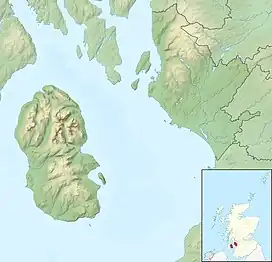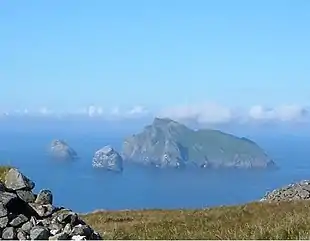Little Cumbrae
Little Cumbrae (Scots: Wee Cumbrae, Scottish Gaelic: Cumaradh Beag) or Little Cumbrae Island[6] is an island in the Firth of Clyde, in North Ayrshire, Scotland. The island is known locally as Wee Cumbrae.
| Scottish Gaelic name | Cumaradh Beag |
|---|---|
| Scots name | Wee Cumbrae |
| Meaning of name | Little island of the Cymric people[1] |
 Little Cumbrae Island from Portencross, North Ayrshire, Scotland | |
| Location | |
 Little Cumbrae Little Cumbrae shown within North Ayrshire | |
| OS grid reference | NS148517 |
| Coordinates | 55.72°N 4.95°W |
| Physical geography | |
| Island group | Islands of the Clyde |
| Area | 313 hectares (1.21 sq mi) |
| Area rank | 84 [2] |
| Highest elevation | Lighthouse Hill 123 metres (404 ft) |
| Administration | |
| Sovereign state | United Kingdom |
| Country | Scotland |
| Council area | North Ayrshire |
| Demographics | |
| Population | 0 |
| References | [3][4][5] |
Etymology
The Gaelic name Cumaradh means "place of the Cymric people", referring to the Brittonic-speaking inhabitants of the Kingdom of Strathclyde.[1] Alternatively, the name Cumbrae may derive from Kil Maura meaning "cell or church of a female saint".[7]
Little Cumbrae was recorded as Kumbrey circa 1300, Cumbraye circa 1330 and Litill Comeray in 1515[7] and was also formerly known as Little or Wee Cumray.[4]
The Cumbraes are referred to as the Kumreyiar in the Norse Saga of Haakon Haakonarson.[8]
Geography

Little Cumbrae lies barely a kilometre to the south of its larger neighbour, Great Cumbrae, a few kilometres distant from the mainland town of Largs. The islands are collectively referred to as The Cumbraes. In stark contrast to its neighbour, green and fertile Great Cumbrae, Little Cumbrae is a rough and rocky island. With its many cliffs and rocky outcrops, Little Cumbrae bears more of a resemblance to a Hebridean island than to some of its neighbours in the Clyde.
A number of uninhabited islets skirt the island's east coast, Castle Isle, the Broad Islands and Trail Isle.
Today the island's main settlement is at Little Cumbrae House on the eastern shore, facing the Scottish mainland.
Geology
Unlike its larger neighbour, Little Cumbrae is formed almost entirely from extrusive igneous rocks. These are a mix of Carboniferous age basalts, mugearite and hawaiite lava flows cut by a similarly aged WSW-ENE aligned dyke of alkali olivine diorite. A later northwest–southeast aligned swarm of dykes of Palaeogene age intrude these rocks whilst several geological faults run generally NW-SE. There are limited outcrops of sedimentary rock in the east, these being of the Eileans Sandstone assigned to the Clyde Sandstone Formation of the Carboniferous age Inverclyde Group. A raised beach is developed along the lower-lying east coast of the island on which have accumulated marine deposits and blown sand. Glacial striations betray the broadly north–south movement of a glacier over the island during the last ice age. Small pockets of peat have accumulated during the post-glacial period.[9]
History

 Little Cumbrae Lighthouse | |
| Location | Firth of Clyde |
|---|---|
| Coordinates | 55°43.2179′N 4°58.0236′W |
| Tower | |
| Constructed | 1793 |
| Construction | Traditional white tower (inoperative) hexagonal/cylindrical tower |
| Automated | 1977 |
| Operator | Clyde Port Authority |
| Light | |
| First lit | 1997 (current tower) |
| Focal height | 92 feet (28 m) |
| Range | nautical miles |
| Characteristic | Fl. W 6 sec |
The Cumbraes were one of the remote locations that early Irish monks settled. There are six or more known caves on the island. A submarine passage was said to run from Monks' Cave (now known as Kings Cave) at Storrils cliff to Kingarth on the Isle of Bute.[10]
Walter Stewart is said to have built a castle or hunting lodge on Little Cumbrae.[11] His son, Robert II spent time there hunting the deer, however the site of the "Auld Castle" is unknown. It was occupied during hunting expeditions by Robert II in 1375 and 1384,[12] and was demolished by Cromwell's soldiers in 1653.[13]
Little Cumbrae Castle, a small square keep, was built in the 16th century on Castle Island off Little Cumbrae. It was similarly occupied.
In the early 20th century, under the ownership of Evelyn Stuart Parker, a new 'mansion house' was created from the original single storey farmhouse, the gardens were laid out to a plan by Gertrude Jekyll, the renowned garden designer, and substantial repairs were undertaken to the castle and the original lighthouse. The original work commenced in 1913, with subsequent alterations made between 1926 and 1929 when the square tower and top floor were added.
Little Cumbrae is the birthplace of James Archbald, the first mayor of Carbondale, Pennsylvania.
Cumbrae lighthouses
| Little Cumbrae Lighthouse Act 1756 | |
|---|---|
| Act of Parliament | |
.svg.png.webp) | |
| Citation | 29 Geo. 2c. 20 |
James Ewing built the first Little Cumbrae lighthouse on the top of Lighthouse Hill in 1757. This was the second lighthouse in Scotland.[14] An open coal fire was lit at the top of a circular stone tower. Remains of this old structure can still be seen and are designated a scheduled monument.[15]
The traditional Cumbrae Lighthouse was designed and built in 1793 by Thomas Smith under commission from the Commissioners of the Northern Lights. The lighthouse lies on a broad raised beach on the western shore of the island looking out into the Firth, 0.5 km from the first light. It had a foghorn, slipway, jetty, and boathouse. The original oil lamps were replaced by Argand lamps in 1826. In 1865, the foghorn was installed; the first in Britain. The tower was restored in 1956 and a solar-powered light was installed in 1974.[14] The 1793 tower has been unused since 1997, with the light on a 36-foot (11-metre) hexagonal/cylindrical tower adjacent to the old generator house.
Ownership
Little Cumbrae was privately purchased in 2003 and there were plans for its development as a memorial park, nature reserve and corporate escape.
The island was sold again in July 2009 for £2 million.[16] The buyers of the island, a Scottish millionaire couple of Indian origin, Sarwan and Sunita Poddar, opened a yoga and meditation centre there with the help of yoga guru Swami Baba Ramdev.[17][18] There have also been rumours of the new owners planning to rename it "Peace Island", but those have been denied.[19][20]
See also
Footnotes
- Mac an Tàilleir p. 36
- Area and population ranks: there are c. 300 islands over 20 ha in extent and 93 permanently inhabited islands were listed in the 2011 census.
- 2001 UK Census per List of islands of Scotland
- Haswell-Smith (2004) pp. 17-18
- "Ordnance Survey". Archived from the original on 16 October 2003. Retrieved 12 November 2007.
- "Little Cumbrae Island". Ordnance Survey. Archived from the original on 9 February 2019. Retrieved 7 February 2019.
- Johnston, p. 93
- "cömbröɣ" Archived 20 March 2012 at the Wayback Machine "Brittonic Language in the Old North". Scottish Place-Name Society. Retrieved 14 September 2011.
- British Geological Survey 2008. Dunoon and Millport, Scotland sheet 29E with part of 21E. Bedrock and superficial deposits. 1:50,000. (Keyworth, Nottingham: BGS)
- Downie, R. Angus (1934). Bute and the Cumbraes. Glasgow & London : Blackie & son Ltd. Page 53
- "Overview of Little Cumbrae". Gazetteer for Scotland. Archived from the original on 16 March 2011. Retrieved 11 November 2007.
- Lytteil, W (1986). Guide book to the Cumbraes. p. 132.
- Chisholm, Hugh, ed. (1911). . Encyclopædia Britannica. Vol. 7 (11th ed.). Cambridge University Press. p. 628.
- "Little Cumbrae". Secret Scotland. Archived from the original on 18 September 2010. Retrieved 17 January 2011.
- Historic Environment Scotland. "Little Cumbrae,lighthouse tower & associated buildings (SM418)". Retrieved 22 February 2019.
- "Little Cumbrae". HLL Humberts Leisure. 10 July 2009. Archived from the original on 29 October 2006. Retrieved 12 July 2009.
- "'Gay cure' yoga guru to set up centre on Scottish island". Pink News. Archived from the original on 11 September 2009. Retrieved 17 September 2009.
- Blakely, Rhys (8 September 2009). "Yoga guru sets up base on Scottish isle". Times Online. London. Archived from the original on 5 October 2021. Retrieved 27 September 2009.
- "Plans about Little Cumbrae". Bramble & Bug Ltd. Archived from the original on 13 October 2009. Retrieved 10 November 2009.
- "Little Cumbrae not to be renamed". Largs and Millport News. 16 September 2009. Archived from the original on 8 December 2009. Retrieved 10 November 2009.
References
- Haswell-Smith, Hamish (2004). The Scottish Islands. Edinburgh: Canongate. ISBN 978-1-84195-454-7.
- Johnston, J. B. (1903). Place-names of Scotland. Edinburgh: David Douglas.
- Iain Mac an Tàilleir. "Placenames" (PDF). Pàrlamaid na h-Alba. Archived from the original (PDF) on 17 March 2007. Retrieved 23 July 2010.
